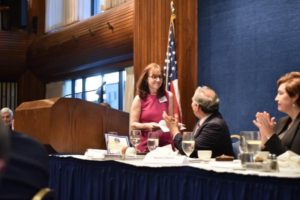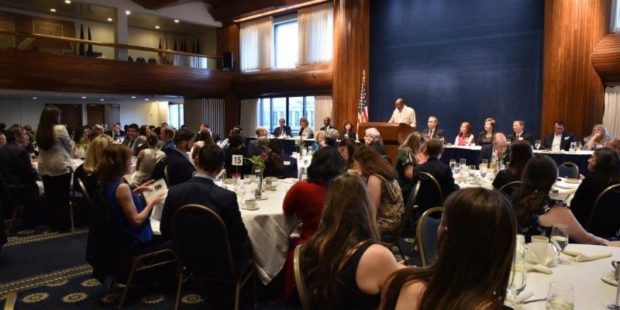
Kojo Nnamdi emcees the June 14, 2022, SPJ DC Pro Chapter Dateline Awards and Hall of Fame dinner at the National Press Club. A large crowd of Dateline Awards contest finalists and other journalism enthusiasts was on hand, after a two-year hiatus for the chapter’s annual awards dinner. In this photo, SDX Foundation of Washington, D.C., scholarship awardee Melanie Martinez-Lopez stands to be recognized (near the left side of the photo). Photo: Louise Krafft
Pierre Thomas, Jane Mayer and Doug Mills joined many storied Washington journalists before them as they entered the DC Journalism Hall of Fame during a dinner and induction at the Washington, D.C., Pro Chapter of the Society of Professional Journalists’ annual meeting June 14, 2022, in the ballroom of the National Press Club.

The honorees each were introduced by a person they selected, then gave a speech themselves* about being a journalist and journalism in general, making for a memorable evening for the audience gathered to honor them, many of whom also were there as finalists in the chapter’s Dateline Awards contest, the winners among them also announced during the evening ceremonies.
The evening’s honors also included the presentation of the Distinguished Service in Local Journalism Award to Frank LoMonte, for his years heading the Student Press Law Center, and recognition of the SDX Foundation of Washington, D.C.’s four scholarship recipients for the academic year beginning in the fall of 2022. Three of the four were able to attend the event, including Adriana Doria, and her mother, Maria Doria, and Melanie Martinez-Lopez, pictured in the audience in the photo above.
Jane Mayer is a staff writer for The New Yorker covering politics, culture and national security. Recently, she’s written extensively about Supreme Court spouse Ginni Thomas’ work with groups involved in cases, including abortion, before the Supreme Court. Previously, Mayer was The Wall Street Journal‘s White House correspondent. She’s written two best sellers, Dark Money: The Hidden History of Billionaires Behind the Rise of the Radical Right (2016) and The Dark Side: The Inside Story of How the War on Terror Turned Into a War on American Ideals (2008).
Susan Glasser introduces Jane Mayer
(remarks as prepared for delivery, with notes incorporated from Jill Abramson, who Ms. Glasser describes as “Jane’s great friend, co-author, and former editor of The New York Times“)
The honoree I have the singular joy of introducing tonight is my friend, New Yorker colleague – and professional idol – Jane Mayer.
In 1994, after “Strange Justice: The Selling of Clarence Thomas” was published, the cover of the conservative magazine, The American Spectator, put Jane on the cover. In the drawing, she was portrayed as a mean terrier, tugging at Justice Thomas’ robes, which she clenched in her jaws. Well, that cover kind of had it right.

No one has been more dogged in investigating and revealing the architecture of the conservative movement than Jane.
Going back to her days as a White House reporter for The Wall Street Journal in the Reagan administration, when she became that paper’s first female White House reporter, she revealed the racist underpinnings of conservative legal theory and disclosed that Jim Baker called Ed Meese Big Bigot and his deputy, Ken Cribb, Little Bigot. Then came her book on Thomas.
She dove into the dubious legality of George W. Bush’s anti-terror policies, especially waterboarding, for The New Yorker and in her best-selling book “The Dark Side.” New Yorker readers were introduced to something she dubbed, The Kochtopus – the empire of conservative groups secretly funded by the Koch Brothers, who were not known as a political force until Jane exposed them. Then, in her next book, “Dark Money,” Jane revealed the huge, undisclosed funding of a truly massive network of conservative funders, foundations and think tanks that exist to promote extremely conservative ideas and political agendas. Over the four years of the Trump presidency, she reported indispensable stories for The New Yorker about Mike Pence, Fox News, Ginni Thomas, Brett Kavanaugh and Mitch McConnell.
The point is that she’s not a mean terrier, she’s a watchdog in exactly the way The Founders intended the free press to be. She holds power accountable, which is why she has fought to tell the truth about the right wing all these years and why her byline remains so influential and respected. Unlike her book titles, which stress the word “dark,” Jane shines the light to reveal the truth to her readers. And the subjects of her investigations, I should point out, are not just on the right. She has held powerful Democrats to account, too, like the New York attorney general who resigned within hours of her reporting, with Ronan Farrow, about his alleged pattern of sexual violence.
Personally, I know from being her friend and colleague, Jane is the opposite of dark. She’s funny and generous.
Jane has won most every honor and award there is in journalism, the George Polk Award, the Robert Kennedy book award, all justified. But I am quite sure she would keep doing what she does with or without any of the recognition. She is, quite simply, the best reporter I have ever met. And also the hardest working one; some early boss at The Wall Stree Journal must have told her that in journalism you are only as good as your next story. But the truth is: Put her in a room with 50 people, one of whom has a great never told story, and before the end of the night she would find the person and get the story. I am sure of it.
I’ll finish with Jane’s own words about this work that she does and that we all aspire to, taken from an interview about investigative reporting Jane took the time to give my son, then 14 years old and a freshman in high school. What she told him was just the essence of our profession and her work: “Dig deep, get the facts, be intimidated by no one and write stories without fear or favor. That’s what we are supposed to do…. And hold everybody in power accountable.”
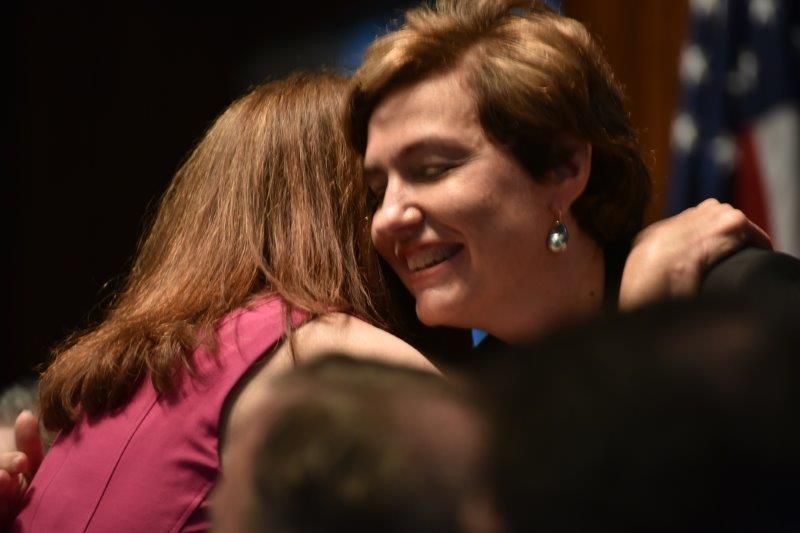
Jane Mayer accepts Hall of Fame induction
Thanks so much, Susan.
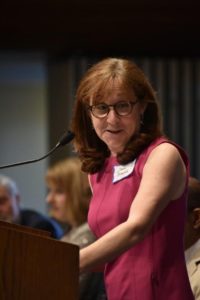
I consider myself incredibly lucky in more ways than I can count but one of them is to have colleagues such as Susan who are not just the very best in the business, they are also true friends. The kinds of people who will come out to the National Press Club on a hot, sticky night in June, and make it sound as if you walk on water when actually they have been throwing you a life vest every other day. Occasionally, it’s more important to be kind than to tell the truth, and I thank Susan for doing that tonight!
I also wanted to thank a few others, since this may be as close as I ever get to an Academy Award moment. A big thank you goes to the Society of Professional Journalists’ DC Chapter for inducting me into its Hall of Fame along with two such wonderful colleagues – Doug Mills and Pierre Thomas – whose work I’ve admired for years. Part of the thrill of being a reporter in Washington is getting to work alongside of so many unbelievably talented people.
I also want to thank David Remnick, the editor of The New Yorker, and my features editor Daniel Zalewski, for giving me what has got to be simply the best job in journalism. I thought when I got hired by The New Yorker in 1994 that it meant getting edited by a bunch of literary geniuses in bowties. I was wrong. The Vogue magazine people with whom we share the glamorous Conde Nast cafeteria in New York call The New Yorker staff “The Waltons” – because they are so sartorially pathetic. But while the editors may not wear bowties, make no mistake about it, they truly are geniuses and among the most dedicated journalists imaginable. No one would believe the lengths they go to, to get the facts right, and make us writers look good. So, I’m incredibly grateful to have the opportunity to work with them.
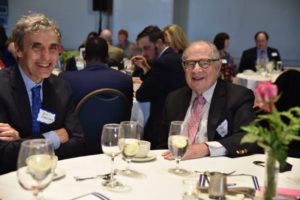
And most of all I want to thank my husband, Bill Hamilton, who is here tonight, and who I turned down when he offered me a job working for him at the Washington Post forty years ago. Luckily, I got a better gig thirty years ago as his wife. As a result, some of the best editorial advice in the world is available in-house – with morning coffee. Bill’s got a well-earned reputation as one of the most talented, and most beloved, editors in the news business, and it’s probably the greatest bit of luck in my life that instead of being my boss, he agreed to be my husband.
It’s fitting that this event tonight arrives almost exactly on the 50th anniversary of the Watergate burglary. I hadn’t planned on being an investigative reporter, but Woodward and Bernstein were actually among my early heroes. My first journalism job – which was working for the smallest weekly newspaper in Vermont – took place during the summer of the Watergate hearings, which we listened to incessantly on the radio as we printed the paper, collated it, and drove it ourselves to our 700 subscribers. Like Woodward and Bernstein, I, too, wanted to blow the lid off something big. But in the tiny town of Weathersfield, Vermont, the only scandal I could find to write about was how greasy the cooking was at the local clam bar.
By the time I became a White House correspondent in 1984, things there seemed pretty tame, too. But I soon discovered to my surprise that just as in Nixon’s day, officials would lie right to a reporter’s face. I came from a nice, upstanding family that taught me that honesty was important, and so I was kind of shocked when for instance the National Security Adviser looked me right in the eye, and swore to me that the tip I’d heard — that he was about to resign — was false. The next morning, the White House put out his resignation letter. I was even more shocked when it turned out that while we glamorous White House correspondents had been sitting in the press room taking notes during the official briefings like chumps, unbeknownst to us, the president and his top aides had been secretly breaking all sorts of laws by selling weapons to Iranian terrorists, and then using the profits to fund an illegal secret war in Nicaragua.
In other words, it was clear that if you became a journalist because you wanted to tell the public the truth, you had to dig beneath the surface. There was a reason, it turned out, that my boss back then, Al Hunt, the Washington bureau chief at The Wall Street Journal, used to repeat to us like a mantra, “If your mother tells you she loves you – check it out.”
Over the years since then, the Washington spin machine has only grown more sophisticated, the amount of money to be followed – as Deep Throat commanded – has exploded, and the need for investigative reporting has become more urgent than ever. We are at a point now where there is basically a war on the truth, and on those who are trying their best to tell it. Those of us old enough to have lived through Watergate know that when those in power call the press “The Enemies of the American People,” we have seen this play before. Nixon, too, tried to stigmatize the press, and destroy its legitimacy. It instead destroyed his.
It’s unclear if that would still happen today. This is not to say that Woodward and Bernstein had it easy. It’s easy to forget that they were attacked too, yet persisted brilliantly before they were lionized as heroes and played by movie stars. But I think what the press is up against today is in many ways even tougher than what they encountered. The political polarization in Congress, as we see with the current hearings into the Jan. 6 insurrection, has made it all but impossible to reach any national consensus on the facts. And the advent of partisan disinformation platforms has undercut the reach and power of fact-based reporting.
As a result, large swaths of the population are being purposefully, and constantly, misled. Our political system is reeling from the blow. Charlie Sykes, the former right-wing radio talk show host, has described the fallout well. “All administrations lie,” he has said, “but what we are seeing here is an attack on credibility itself.”
In the face of this challenge, as my friend, and former co-author, Jill Abramson, the former editor of The New York Times recently put it, “The truth needs to get louder.”
I think the good news is that, almost every day, that is happening. Despite the challenging climate, journalists have rarely worked harder or done better or more vital work. I really admire the younger generation of investigative reporters who are turning out one killer story after the next, despite the difficulty of working in an age of instant and constant online vitriol. This is especially true of the female reporters who face down a disgraceful amount of misogyny on Twitter, and other platforms.
Yet in the end of the day, I am betting that democracy, and the facts that sustain it – not the “alternative facts” that the previous administration touted – but the real ones, will win. It may take a fight, and it may not happen overnight. But what rings in my ears every so often are the words of a long-time Koch Industries employee named Phil Dubose, who I interviewed for my book “Dark Money.” At the risk of personal ruin, even though he was just a middle-class guy from Louisiana living in a small house with a couple of hound dogs, he testified as a witness in a trial against the company’s atrocious record of pollution and fraud. To the surprise of many, despite marshalling all the resources of their $150 billion fortunes – which made them among the richest and most powerful men in the world – the Koch Brothers were found guilty and forced to pay a record-breaking fine.
“We won,” Phil Dubose told me, “because they didn’t have a weapon as big as the one we used.”
“What was that?” I asked him.
He answered with two simple words: “The truth.”
These are trying times, but the truth is very much alive, and I am thankful to be part of a profession, with so many of the others in this room, that is dedicated to making sure it gets told. It’s been my privilege, and my honor.
So, thank you all.
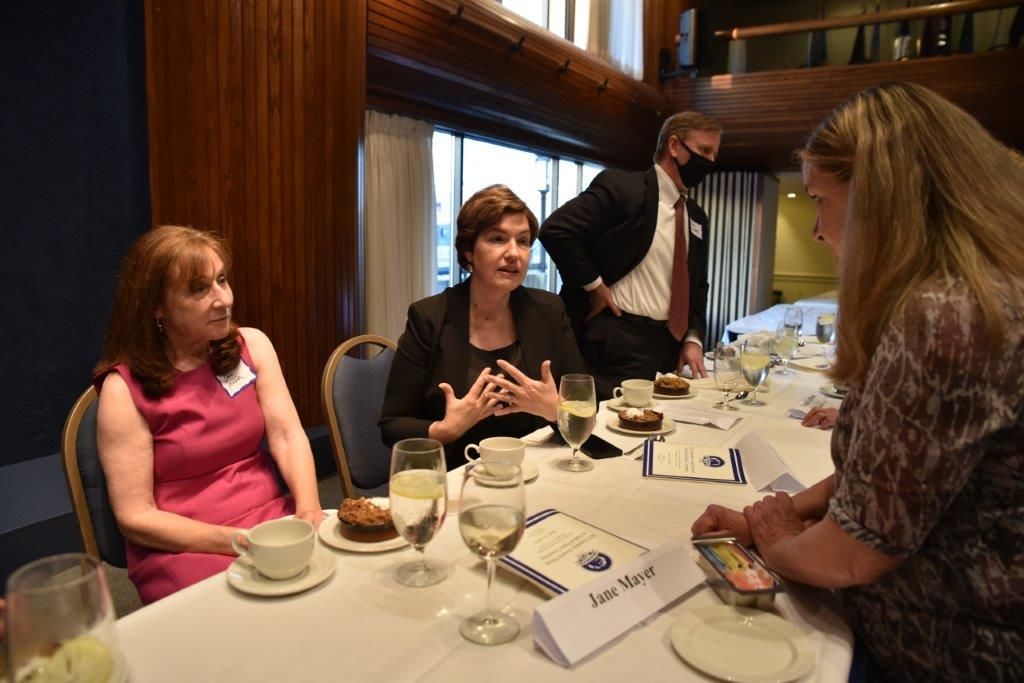
~~~~~
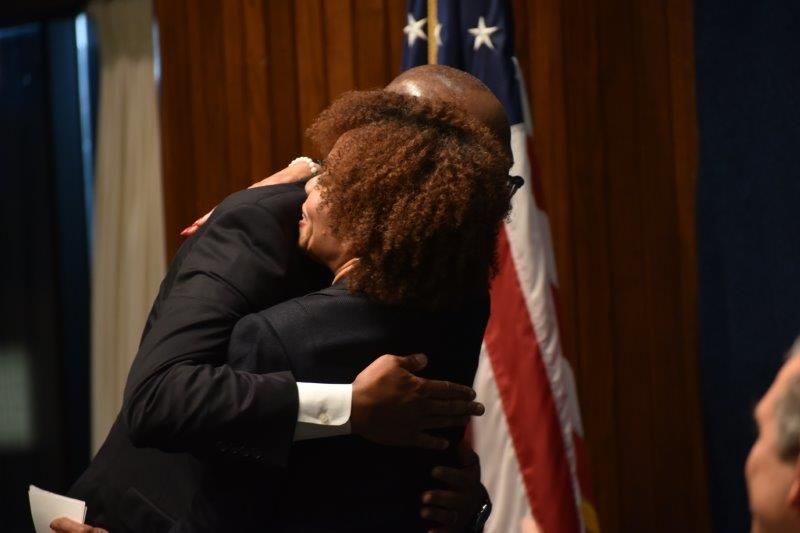
(The introduction by Kim Godwin of Pierre Thomas will be posted soon, along with more photos. A separate post for the speech by Distinguished Service Award honoree Frank LoMonte is here.)
* Doug Mills, who along with the other honorees had committed to attend the dinner in 2020, when all were originally to be inducted, was unable to attend June 14 due to circumstances that arose closer to the date of the dinner in 2022. Due to the COVID-19 pandemic restrictions on indoor gatherings, the chapter’s annual dinner was not held in 2020 or in 2021.

